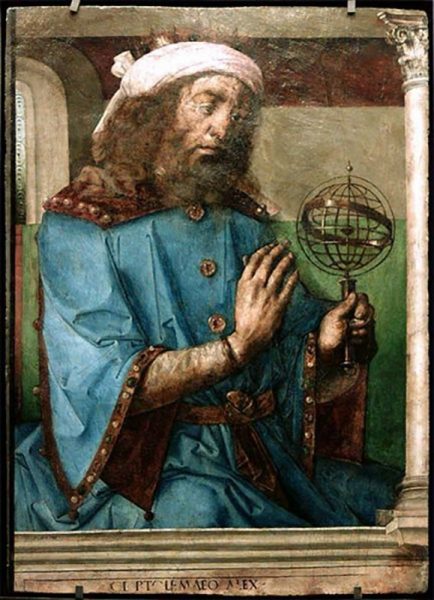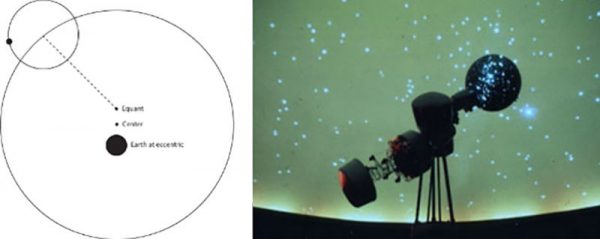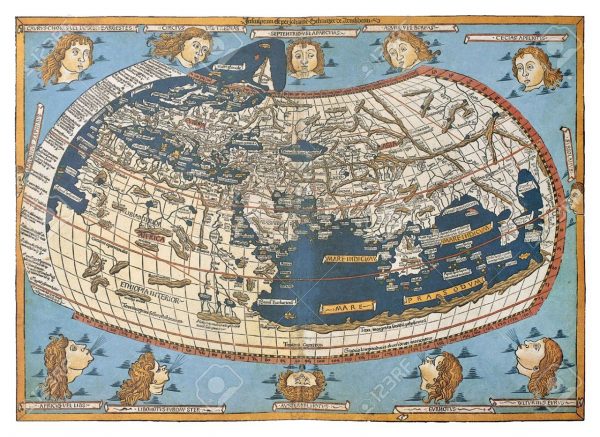A 2nd Century Egyptian astronomer

Claudius Ptolemy, Latin in full Claudius Ptolemaeus (born c. 100—died c. 170), was an Egyptian astronomer, mathematician, and geographer of Greek descent who flourished in Alexandria during the 2nd century. The name Claudius Ptolemaeus is composed of the Greek name Ptolemaeus and the Roman name Claudius. However, he is believed to have been born in Thebaid (a region in ancient Egypt). At this time Egypt was part of the Roman Empire which would have made his nationality Roman. He was one of the most well-known astronomers of the second century and has made significant contributions in the field of astronomy, geography, mathematics, astrology and physics.
Ptolemy presented a useful tool for astronomical calculations in his Handy Tables, which tabulated all the data needed to compute the positions of the Sun, Moon and planets, the rising and setting of the stars, and eclipses of the Sun and Moon. Ptolemy’s Handy Tables provided the model for later astronomical tables or zījes (astronomical handbooks of the Handy Tables) Ptolemy also produced a star calendar or almanac, which kept track of the solar year via various star phases.
Virtually nothing is known about Ptolemy’s life except what can be inferred from his writings. His first major astronomical work, the Almagest, was completed about c. 150 and contains reports of astronomical observations that Ptolemy had made over the preceding quarter of a century and is one of the most important works in ancient astronomy. It also contains a catalogue of stars with their brightness on a logarithmic scale.
In this, he put together his own ideas with those of Aristotle and Hipparchus which formed the geocentric theory. The Almagest also contains a star catalogue, which is a version of a catalogue created by Hipparchus. Its list of forty-eight constellations is ancestral to the modern system of constellations, but unlike the modern system, they did not cover the whole sky (only the sky Hipparchus and Ptolemy could see).
Across Europe, the Middle East and North Africa in the medieval period, it was the authoritative text on astronomy and is the only surviving comprehensive ancient treatise on astronomy. How much of the Almagest is original is difficult to determine because almost all of the preceding technical astronomical literature is now lost. Ptolemy credited Hipparchus (mid-2nd-century BCE) with essential elements of his solar theory, as well as parts of his lunar theory while denying that Hipparchus constructed planetary models. There has been some controversy over Ptolemys claims, especially as an observer. Astronomer Tycho Brahe (1546–1601) pointed out that solar observations Ptolemy claimed to have made in 141 are could not be genuine, and there are strong arguments for doubting that Ptolemy independently observed the 1,000+ stars listed in his star catalogue.
What is not disputed, however, is the mastery of mathematical analysis that Ptolemy exhibited. His model of the solar system and the heavenly sphere was a refinement of previous models developed by Greek astronomers. Ptolemy’s major contribution, however, was that his model could so accurately explain the motions of heavenly bodies, it became the model for understanding the structure of the solar system. Ptolemy’s version of the solar system assumed that the Earth was the centre of not only the solar system but the entire universe. The Ptolemaic model accounted for the apparent motions of the planets in a very direct way, by assuming that each planet moved on a small sphere or circle, called an epicycle, which moved on a larger sphere or circle, called a deferment. The stars, it was assumed, moved on a celestial sphere around the outside of the planetary spheres.
Ptolemy’s fame comes partly from what he figured out, but his influence was because he wrote a great summary of everything known about astronomy. Ptolemy insisted that the job of the astronomer was to explain the motions of the wanderers using only uniform circular motion – the kind of motion that most gears and wheels show. To make the planets appear to speed up and slow down, three tricks were used. The epicycles were the first trick. The second trick was to move the observer out of the centre of the circle, putting us into an “eccentric” position. The third trick was called the equant and is illustrated here:

As an indication of exactly how good the Ptolemaic model is, modern planetariums are built using gears and motors that essentially reproduce the Ptolemaic model for the appearance of the sky as viewed from a stationary Earth. In the planetarium projector, motors and gears provide uniform motion of the heavenly bodies. One motor moves the planet projector around in a big circle, which in this case is the deferment, and another gear or motor takes the place of the epicycle. While the fact that we base planetarium projectors on the Ptolemaic model of the universe that was developed almost 2,000 years ago may seem impressive, a better test of the model is how long the model was accepted by society. In this case, the Ptolemaic model was not seriously challenged for over 1,300 years.
Ptolemy was the first person to use longitude and latitude lines to identify places on the face of the Earth and wrote a book The Geographia in which he described the world geography in those times. The maps given by Ptolemy spanned 180 degrees of longitude from the Canary Islands to China, and 80 degrees of latitude from the Arctic to the East Indies. Christopher Columbus and Magellan had used Ptolemy’s version of the world map on their voyages although it was very inaccurate.

The Ptolemy Stone
An astronomical instrument invented by Ptolemy to measure the altitude of celestial bodies and is used in the mathematics courses at both St. John’s College campuses. This device was the precursor to the sextant.
Students learn to use this stone to calculate the apparent movement of the sun along the ecliptic.
Ptolemy’s Canon
The Canon of Kings was a dated list of kings used by ancient astronomers as a convenient means to date astronomical phenomena, such as eclipses. The Canon was preserved by Ptolemy and is thus known sometimes as Ptolemy’s Canon. It is one of the most important basis for our knowledge of ancient chronology.
Ptolemy’s Table Of Chords
Is a trigonometric table in Ptolemy’s Almagest, a treatise on mathematical astronomy.
It is essentially equivalent to a table of values of the sine function. It was the earliest trigonometric table extensive enough for many practical purposes, including those of astronomy (an earlier table of chords by Hipparchus gave chords only for arcs that were multiples of 7½° = π/24 radians).
Centuries passed before more extensive trigonometric tables were created.
Ptolemy’s theorem – mathematical theorem described by Ptolemaeus.
Items named after Ptolemy:
- The crater Ptolemaeus on the Moon
- The crater Ptolemaeus on Mars
- The asteroid 4001 Ptolemaeus
- Ptolemy Cluster, star cluster described by Ptolemaeus and later catalogued by Charles Messier as Messier 7.





